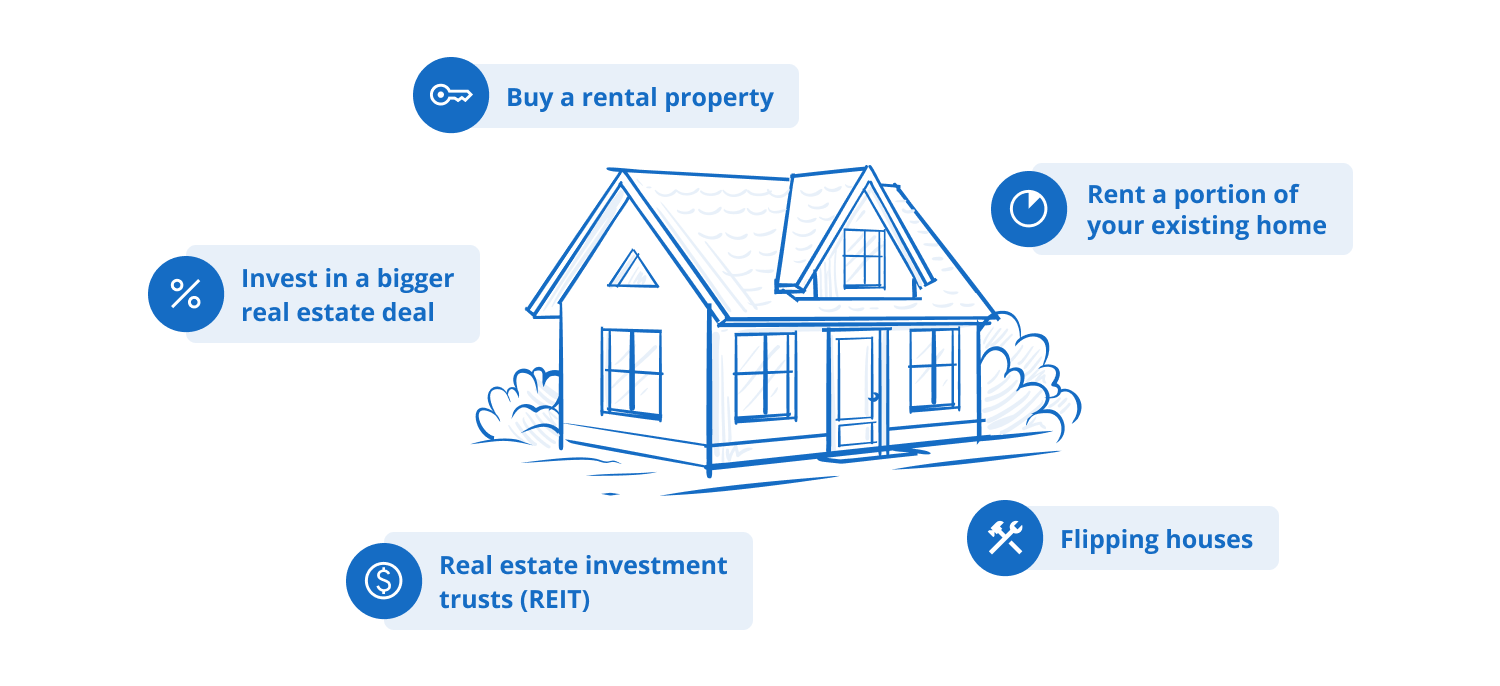4 ways to invest in real estate
Exploring different ways to invest in real estate, plus what to consider
Ways to invest in real estate: There are multiple pathways, from owning property directly and REITs to crowdfunding and strategies such as rental and flipping models.
Real estate investing for beginners: Beginners might prioritize education, financing knowledge, and market research before investing their money.
What to consider when investing in real estate: Important considerations include due diligence, cost analysis, diversification, and aligning investments with long-term goals.
What is real estate investing?
Real estate investing involves putting money into property or real estate-related assets with the goal of generating income or capital growth. It encompasses various types of properties, including residential homes, commercial buildings, and industrial facilities.
Investors can participate through direct ownership of physical properties or indirectly via real estate investment trusts (REITs) and crowdfunding platforms, which offer exposure without the responsibilities of property management.
Each approach varies in terms of risk, control, liquidity, and capital requirements, providing multiple entry points for different investor profiles.
How to start investing in real estate
For many investors, real estate investing starts with understanding financial goals and choosing the right investment strategy — whether it’s rental properties, house flipping, or real estate investment trusts (REITs). Initial steps might include researching your local market, securing financing, and building a network of real estate professionals such as agents, lenders, and contractors. It’s also important to learn the basics of property valuation, rental income, and expenses. Some investors might prefer to start with a small, manageable investment, and grow their portfolio as they gain experience and confidence.
4 ways to invest in real estate
When it comes to the different ways to invest in real estate, there isn’t a one-size-fits-all approach. The options available vary widely in terms of involvement, risk, capital required, and potential returns. Understanding these different paths is crucial to selecting a strategy that fits your financial goals, risk tolerance, and available resources.
1. Direct ownership (buying property)
Direct ownership means purchasing a physical property such as a single-family home, multi-family building, or commercial space. This method provides control over the asset and potential income through rentals or appreciation but requires active management and upfront capital.
2. Real Estate Investment Trusts (REITs)
REITs pool investor funds to buy and manage income-generating properties. Shares in REITs trade on stock exchanges, providing liquidity and diversification. They offer an accessible option for investors seeking real estate exposure without owning property outright.
3. Real estate crowdfunding platforms
Crowdfunding platforms allow investors to collectively fund specific real estate projects or portfolios, often with lower minimum investments. While this can offer attractive returns and diversification, crowdfunding investments may have longer lock-in periods and platform-specific risks.
4. Rental vs. flipping models
Investors often choose between two common strategies for profiting from real estate: holding properties for rental income or buying and selling quickly for capital gains. Rental properties generate income through tenant leases and benefit from long-term property appreciation. Flipping involves buying undervalued properties, renovating them, and selling them for a profit, offering quicker returns but higher risk.

Real estate investing for beginners
Starting out in real estate investing can be complex and inherently risky, but with structured learning and careful planning, beginners can build a strong foundation. The following considerations help demystify the process of real estate investing for beginners and prepare you to make informed decisions.
Education and research: Before investing, it’s important to understand different property types, market forces, and legal requirements. It can help to study residential, commercial, and industrial real estate dynamics, focusing on supply and demand, price trends, and risk factors. Engage with educational resources such as books, webinars, and local real estate groups to build foundational knowledge. Familiarize yourself with landlord-tenant laws, zoning rules, and disclosure regulations relevant to your target market to avoid legal pitfalls.
Financing options: A solid grasp of financing options is essential for effective real estate investing. Learn about mortgage types — fixed-rate, adjustable-rate, interest-only — and explore alternatives like partnerships and seller financing. Evaluate loan terms, interest rates, and closing costs to minimize expenses. Investors with a good credit score and financial discipline may be able to secure favorable financing conditions.
Market analysis: Successful investing hinges on selecting the right location. Analyze factors such as population growth, job opportunities, infrastructure development, and rental demand. Emerging neighborhoods may offer greater appreciation potential, while established areas might offer more stability. Consider the quality of schools, crime rates, and local amenities, as these influence tenant desirability and property values. Leverage online databases and economic forecasts for comprehensive market insights.
- Lower-barrier investment vehicles: For newcomers reluctant to buy physical properties, REITs and crowdfunding platforms offer accessible entry points with lower capital requirements and reduced management responsibilities. REITs can bring diversification, while crowdfunding may enable investment in specific projects with modest minimums. It is important to investigate each platform’s track record, fees, and terms carefully before committing funds.
What to consider when investing in real estate
Successful real estate investing involves more than just buying property. Carefully evaluating multiple factors ensures your investment aligns with your financial goals and risk tolerance.
Due diligence: Performing thorough due diligence can help uncover potential issues before purchase. Inspect property conditions, review ownership history, check for liens or zoning restrictions, and evaluate environmental risks. Use professional inspectors and legal advisors to validate disclosures and compliance. Assess tenant profiles, lease agreements, and historical income to gauge the property’s true financial potential.
Costs beyond purchase price: Budget realistically for ongoing expenses beyond the initial purchase. Property taxes, insurance, maintenance, management fees, and occasional repairs can significantly impact cash flow. Account for vacancy periods and tenant turnover costs, such as cleaning and refurbishing. These ongoing expenditures can affect net returns from an investment.
Diversification: Some investors diversify their real estate holdings across different property types, regions, and investment vehicles with the goal of spreading risk. This strategy might involve avoiding over-concentration in one market or asset class, which can mean being exposed to localized downturns. A balanced portfolio is thought to enhance resilience.
- Long-term financial goals: Clarify your investment objectives — whether generating passive income, capital growth, or portfolio diversification — and ensure your real estate strategy supports these aims. Consider your investment horizon, liquidity needs, and risk tolerance. Real estate is generally illiquid and requires patience to realize potential gains.
What are the pros and cons of real estate investing?
Real estate investing has long been valued for its wealth-building potential, yet like any investment, it carries both advantages and drawbacks.
Potential benefits
- Ownership of a tangible asset that can appreciate in value: A feature that draws investors to real estate is owning a physical asset that typically appreciates over time. Unlike stocks or bonds, real estate is a tangible investment — land and buildings you can see and use. This physical presence can provide a sense of security and stability, especially during times of market volatility. However, the potential for appreciation depends on factors like location, economic growth, and property improvements.
Potential for regular rental income: Real estate can generate steady cash flow through rental income. For many investors, rental properties serve as a reliable source of monthly income that can cover expenses and build wealth gradually. Over time, rental rates tend to rise with inflation, enhancing income potential. This income stream may be appealing for those seeking passive income or supplementing retirement funds.
Ability to leverage financing for greater purchasing power: By using mortgages or loans, investors may be able to purchase properties worth more than their initial capital outlay. This ability to control larger assets with less money upfront magnifies potential gains on appreciation and income. However, leveraging finance also comes with risk.
Tax advantages: Real estate investments come with several tax benefits, such as deductions for mortgage interest, property depreciation, and maintenance expenses. These incentives can improve after-tax returns.
- Inflation hedge: Real estate is often considered an effective hedge against inflation. As prices rise, so do property values and rental incomes, helping preserve purchasing power compared to fixed-income investments.
Potential challenges
- High upfront and ongoing costs: Real estate investing requires substantial capital not only to purchase the property but also to maintain it. Upfront costs include down payments, closing fees, inspections, and possible renovations. Ongoing expenses like property taxes, insurance, maintenance, and property management can reduce net income. Unexpected repairs or capital improvements can also strain budgets.
Market fluctuations affecting property values: Property markets are subject to cycles and economic influences. Local downturns, changes in interest rates, or economic recessions can lead to decreased property values and rental demand.
Active management responsibilities unless outsourced: Owning rental properties often means dealing with tenant issues, repairs, and property upkeep. This management role can be time-consuming and stressful. While hiring a property manager can alleviate this burden, it comes at an additional cost and may reduce overall returns.
Illiquidity and exit challenges: Unlike stocks, real estate cannot be sold instantly. The process of marketing, negotiating, and closing a sale can take months, which means your capital may be tied up longer than desired.
- Risk of loss and speculative nature: Real estate investing is not risk-free. Poor property selection, over-leveraging, or adverse market conditions can lead to financial losses. Some investments, particularly in development or flipping, are speculative and require expertise.
Bottom line
Real estate investing offers diverse ways to build wealth, from hands-on property ownership to indirect REITs and crowdfunding. Each of the ways to invest in real estate has unique advantages and risks that require careful planning.
At Raisin, you can explore a variety of savings products, including certificates of deposit (CDs). CD accounts offer a fixed rate of return for a set term. Simply compare interest rates, select a savings product to suit your needs, create your Raisin login, and deposit your money.
FAQs about real estate investing
How much money do you need to start investing in real estate?
This varies widely depending on the method you choose. Direct property ownership typically requires enough for a down payment (often 10–20% of the property price), closing costs, and initial repairs or improvements. When it comes to Real Estate Investment Trusts (REITs) or crowdfunding platforms, you can typically start with much smaller amounts.
Is real estate investing risky for beginners?
All investments carry some degree of risk, and real estate is no exception. Investors face risks such as market volatility, unexpected expenses, and management challenges. It’s important to assess your risk tolerance and invest accordingly.
Can you invest in real estate without buying property?
Yes, indirect investment options allow you to gain exposure to real estate markets without owning physical property. REITs are publicly traded companies that invest in income-producing real estate. Real estate crowdfunding platforms pool funds from many investors to finance specific projects or portfolios, usually with lower minimum investments.
What’s the difference between residential and commercial real estate investing?
Residential real estate includes single-family homes, apartments, and condominiums, typically leased to individuals or families. These investments often have more stable demand but require dealing with tenant turnover and maintenance. Commercial real estate includes office buildings, retail centers, warehouses, and industrial properties leased to businesses. Commercial leases tend to be longer and potentially more complex. The two also differ in terms of financing, management, legal requirements, and market dynamics.
Related Content
The above article is intended to provide generalized financial information designed to educate a broad segment of the public; it does not give personalized tax, investment, legal, or other business and professional advice. Before taking any action, you should always seek the assistance of a professional who knows your particular situation for advice on taxes, your investments, the law, or any other business and professional matters that affect you and/or your business.


